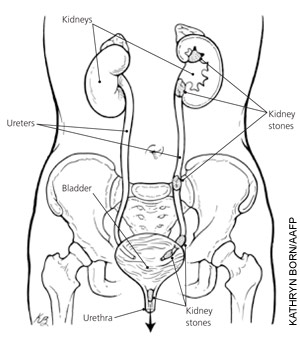
Am Fam Physician. 2006;74(1):99-100
See related article on urinary calculi.
What are kidney stones?
Kidney stones are hard lumps that your body makes from waste products in your urine. If these lumps are big enough, they can get stuck in your bladder or urinary tract (see drawing). This can be very painful.

Who gets kidney stones and why?
Kidney stones are more common in men, but women also can get them. Most people who get them are between 30 and 50 years old. Kidney stones usually are caused by not drinking enough water and eating too much meat or salty foods. You are more likely to get kidney stones if someone in your family has had them. Kidney stones also can be caused by urinary tract infections.
How do I know if I have a kidney stone?
Kidney stones usually cause bad crampy pain in your side. The pain can move toward your groin. You may feel sick to your stomach or have blood in your urine. You also may have a fever. Your doctor can take x-rays or do a urine test to see if you have kidney stones.
How are kidney stones treated?
You might be able to pass the stone in your urine if it is small enough. Your doctor can give you medicine to help with the pain. If the stone is too big, your doctor can use a special machine that breaks the stone into smaller pieces. Your doctor also can put a very thin telescope into your urethra (say: yoo-REETH-ra) to find the stone. Then he or she can pull it out or break it into smaller pieces. If your doctor does this, he or she will give you medicine to numb the area first. Sometimes surgery is the only way to get rid of kidney stones.
What can I do to keep from getting another kidney stone?
Most people with kidney stones have a 50-50 chance of getting another one within 10 years. But there are things you can do to lower your risk:
Drink enough fluids to make 2 liters of urine per day (about 2 quarts).
Do not eat more than 1,500 mg of salt per day (about 1 teaspoon). This includes salt in prepackaged food. Check nutrition labels to see how much salt (sodium) is in your food.
Do not eat more than two servings of meat per day. Each serving should be about 6 to 8 ounces (the size of a deck of cards).
Eat a moderate amount of foods with calcium, such as milk, cheese, and other dairy foods. If your kidney stones are made from calcium, you do not have to stop eating dairy foods. One or two servings per day is okay.
If you have had more than one kidney stone, your doctor might send you to a specialist to find the exact cause of your stones. Some people need medicine to keep from getting another kidney stone.
Where can I get more information?
Your doctor.
American Urological Association
Telephone: 1-866-RING AUA (1-866-746-4282)
Web site:http://www.auanet.org
National Kidney and Urologic Diseases Information Clearinghouse